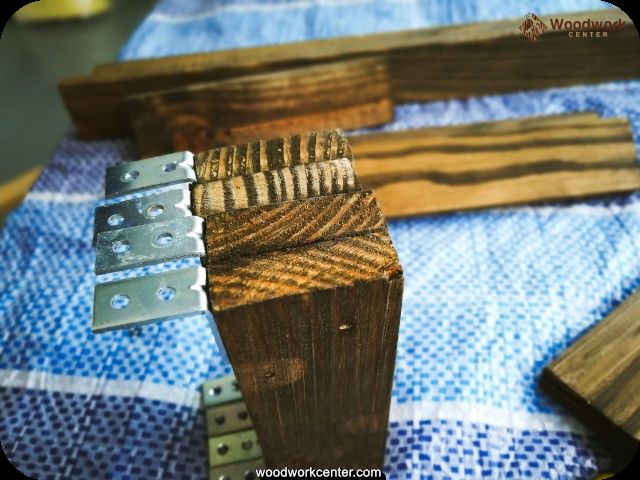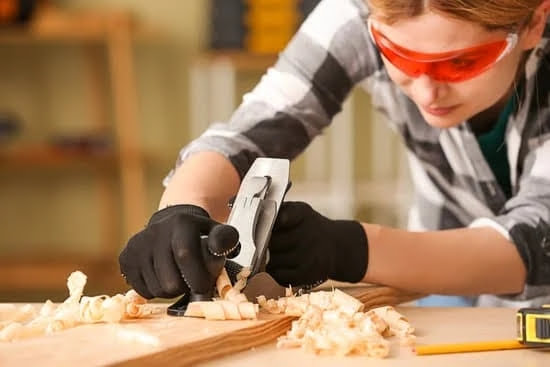Are you looking for ways to connect things in woodworking without making the connection permanent? Whether you’re a beginner or an experienced woodworker, non-permanent joinery techniques can offer versatility and flexibility in your projects. In this article, we will explore different methods and tools for creating connections that can be easily disassembled or adjusted, giving you the freedom to modify your designs as needed.
When it comes to non-permanent woodworking, there are various joinery techniques and fastening methods that can be used to create strong and durable connections. From clamps and connectors to specialized fasteners, understanding how to utilize these tools effectively can greatly expand your woodworking capabilities. By learning about these techniques, you’ll be able to tackle a wider range of projects with confidence and precision.
Throughout this article, we will delve into the tools and materials needed for non-permanent woodworking, explore different joinery techniques, provide step-by-step guides for using clamps, and offer tips for selecting the right connection method for your specific project. Additionally, we’ll discuss common mistakes to avoid when using non-permanent woodworking techniques and provide inspiration for incorporating these methods into your own woodworking projects.
Whether you’re interested in temporary assemblies or adjustable designs, embracing non-permanent woodworking connections opens up endless possibilities for creative expression.
Tools and Materials Needed for Non-Permanent Woodworking
Non-permanent woodworking connections offer flexibility and versatility in your projects, allowing you to assemble and disassemble items as needed. To achieve successful non-permanent woodworking, you’ll need some essential tools and materials at your disposal.
One of the key tools you’ll need for non-permanent woodworking is a set of clamps. Clamps enable you to firmly hold pieces of wood together during assembly without the need for permanent fasteners like nails or screws. There are various types of clamps available, including bar clamps, pipe clamps, and C-clamps, each with its own unique application.
In addition to clamps, having a quality set of woodworking connectors and fasteners is crucial for non-permanent woodworking. Connectors such as dowels, screws with inserts, and knock-down fittings provide reliable joints that can be easily assembled and disassembled when needed. Fasteners like cam locks and bolts with wing nuts also offer a secure way to connect wood pieces without permanent attachment.
Lastly, it’s important to have precision measuring tools such as a combination square, marking gauge, or tape measure to ensure accurate cuts and joinery when working on non-permanent woodworking projects.
| Tools/Materials | Application |
|---|---|
| Clamps (bar clamps, pipe clamps, C-clamps) | Firmly hold pieces of wood together during assembly |
| Woodworking connectors (dowels, screws with inserts) | Provide reliable joints that can be easily assembled/disassembled |
| Fasteners (cam locks, bolts with wing nuts) | Secure way to connect wood pieces without permanent attachment |
| Precision measuring tools (combination square, marking gauge) | Ensure accurate cuts and joinery |
Understanding Different Non-Permanent Joinery Techniques
Non-permanent joinery techniques in woodworking are essential for creating versatile and flexible connections between wood pieces without the need for permanent adhesives or fasteners. Understanding these techniques is crucial for woodworking enthusiasts who want to be able to disassemble and reassemble their projects as needed. There are several non-permanent joinery techniques that can be employed, each with its own unique advantages and applications.
One popular non-permanent joinery technique is using dowels or pegs to connect wooden pieces. This method involves drilling corresponding holes into the pieces to be joined and then inserting a wooden dowel or peg to create a strong and durable connection. This technique is often used in furniture making and cabinetry, as it provides a sturdy joint that can be disassembled if necessary.
Another common non-permanent joinery technique is the use of wedges. Wedges are often used in conjunction with other joinery methods such as mortise and tenon or dovetail joints to create a secure yet removable connection. By hammering a wedge into a slot near the joint, woodworkers can tighten the connection without using permanent fasteners, allowing for easy disassembly in the future.
Biscuit joinery is also a popular non-permanent technique that involves cutting matching slots in two pieces of wood and then inserting an oval-shaped biscuit made from compressed wood particles soaked in glue. When the biscuit comes into contact with the glue inside the slots, it swells, creating a tight bond between the two pieces of wood.
This method allows for strong yet detachable connections, making it ideal for constructing cabinets, tables, and other furniture items. Learning how to connect things woodworking not permanently opens up new possibilities for creative projects that require flexibility and adaptability.
| Non-Permanent Joinery Technique | Applications |
|---|---|
| Dowels/Pegs | Furniture making, cabinetry |
| Wedges | Mortise and tenon joints, dovetail joints |
| Biscuit joinery | Cabinets, tables, furniture items |
Step-by-Step Guide to Using Clamps for Non-Permanent Connections
Clamps are essential tools for creating non-permanent connections in woodworking projects. Whether you’re assembling pieces for a temporary structure or creating a project that may need to be disassembled in the future, using clamps can provide the necessary stability without the need for permanent adhesives or fasteners. Here’s a step-by-step guide on how to use clamps effectively for non-permanent woodworking connections.
- Step 1: Gather your materials
- Step 2: Position the pieces
- Step 3: Apply the clamps
Before starting, make sure you have all the necessary materials at hand. This includes the clamps you’ll be using, as well as the pieces of wood that need to be connected. Choose the appropriate type and size of clamps for your specific project.
Once you have your materials ready, position the pieces of wood in the desired alignment. Use measuring tools to ensure they are precisely positioned before applying the clamps.
Carefully place the clamps over the joints where the pieces of wood meet. Make sure they are firmly secured but not over-tightened, as this could cause damage to the wood.
Using clamps for non-permanent woodworking connections offers a versatile and adjustable method for assembling and holding pieces together during a project. With proper technique and attention to detail, this method allows for flexibility and reusability in various woodworking endeavors. Whether it’s for prototyping, temporary structures, or projects that may need future modifications, mastering clamp usage in woodworking is an invaluable skill to possess.
It is important to note that while clamps provide an excellent non-permanent connection method, they should be used in conjunction with other complementary techniques such as joinery or fasteners depending on the specific requirements of each project. By understanding how to effectively connect things in woodworking not permanently using a combination of tools and methods, woodworkers can achieve greater flexibility and versatility in their creations.
Exploring the Versatility of Woodworking Connectors and Fasteners
Woodworking connectors and fasteners play a crucial role in creating non-permanent connections in woodworking projects. These versatile tools and materials allow woodworkers to join pieces together securely without the need for permanent adhesives or screws. Whether it’s for temporary assembly, disassembly, or simply for added flexibility in design, woodworking connectors and fasteners offer a range of options for different applications.
The following are some common woodworking connectors and fasteners:
- Cam Locks: Cam locks are simple and effective fasteners that provide strong connections between two pieces of wood. They are often used in flat-pack furniture assembly and can be easily adjusted or removed when needed.
- Dowels: Dowels are cylindrical rods that are used to reinforce joints in woodworking. They offer a traditional yet reliable method for creating non-permanent connections that can withstand a fair amount of weight and stress.
- Clamps: Clamps come in various types such as bar clamps, spring clamps, and C-clamps, among others. These tools are essential for holding pieces together during gluing or assembly, allowing woodworkers to create temporary connections while the adhesive sets.
- Hidden Brackets: Hidden brackets provide a discrete way to connect shelves, countertops, and other wooden components. They offer strength and stability while remaining out of sight, making them an ideal choice for non-permanent installations.
Understanding how to utilize these connectors and fasteners is essential for achieving successful non-permanent connections in woodworking projects. By incorporating these tools into your arsenal, you can expand your design possibilities and create pieces that are not only well-built but also adaptable to different needs.
When selecting the right woodworking connector or fastener for your project, consider factors such as load capacity, ease of installation, aesthetics, and reusability. By taking these aspects into account, you can ensure that your non-permanent connections meet the specific requirements of your woodworking endeavor while offering the flexibility you desire.
Tips for Choosing the Right Non-Permanent Connection Method for Your Project
When it comes to non-permanent woodworking connections, choosing the right method for your project is crucial. With a variety of techniques and tools available, selecting the appropriate method can make or break the success of your woodworking project. Here are some tips to help you choose the right non-permanent connection method for your next woodworking endeavor.
Consider the Project Requirements
Before deciding on a non-permanent connection method, carefully consider the specific requirements of your woodworking project. Take into account factors such as the weight-bearing capacity needed, the type of wood being used, and the overall design and aesthetics of the piece. For example, if you’re working on a lightweight and portable project, using removable fasteners like screws or bolts may be more suitable than traditional joinery techniques.
Evaluate Ease of Disassembly
One important aspect to consider when choosing a non-permanent connection method is how easily it can be disassembled. If you anticipate needing to dismantle or modify your project in the future, opting for connectors or fasteners that allow for easy disassembly will be beneficial. This could include quick-release clamps, snap-on connectors, or other adjustable hardware that facilitates reconfiguration without causing damage to the wood.
Explore Versatility and Reusability
Another factor to keep in mind is the versatility and reusability of your chosen non-permanent connection method. Some connectors and fasteners can be used across different projects and wood types, providing flexibility for future woodworking endeavors. Additionally, considering environmentally friendly options that promote sustainable practices can also play a role in selecting the right non-permanent connection method.
By carefully considering these tips when choosing a non-permanent connection method for your woodworking project, you can ensure that your piece is not only well-constructed but also adaptable and versatile for years to come. Understanding how to connect things woodworking not permanently will open up a world of possibilities for unique and customizable woodworking projects.
Common Mistakes to Avoid When Using Non-Permanent Woodworking Techniques
Not Understanding the Strength of Different Joinery Techniques
One common mistake when using non-permanent woodworking techniques is not fully understanding the strength and limitations of different joinery methods. It’s important to research and learn about different types of joinery, such as using dowels, biscuits, or pocket screws, to ensure that your project will have the necessary structural integrity. Without this knowledge, you may end up choosing a connection method that is not suitable for your project, leading to instability and potential safety hazards.
Ignoring Precision in Measurements and Cuts
Another crucial mistake to avoid when utilizing non-permanent woodworking techniques is ignoring precision in measurements and cuts. Whether you’re using clamps, connectors, or fasteners, precise measurements and accurate cuts are essential for creating strong and durable connections. Failing to take precise measurements or make accurate cuts can result in misalignment and ill-fitting joints, compromising the stability of your woodworking project.
Overlooking Proper Clamping Techniques
When using clamps for non-permanent woodworking connections, overlooking proper clamping techniques can be a significant mistake. Incorrectly applying clamping pressure or using inadequate numbers of clamps can lead to gaps in joints or uneven pressure distribution, ultimately weakening the integrity of the connection. It’s vital to understand the correct way to position and apply clamps for each specific joint to ensure a secure bond without causing damage to the wood.
Avoiding these common mistakes will help you effectively utilize non-permanent woodworking techniques while ensuring the strength and durability of your projects. By understanding joinery strength, prioritizing precision in measurements and cuts, and applying proper clamping techniques, you can create stable and reliable connections without permanently altering your woodworking pieces.
Inspiration and Ideas for Non-Permanent Woodworking Projects
When it comes to non-permanent woodworking projects, the possibilities are endless. Whether you are a beginner or an experienced woodworker, there are plenty of creative and practical ways to incorporate non-permanent connections into your projects.
One popular idea is creating modular furniture pieces that can be easily assembled and disassembled, making them convenient for moving or reconfiguring a space. Another great idea is designing decorative partitions or screens using non-permanent joinery techniques, allowing you to change the layout of a room without committing to a permanent wall.
For those who enjoy outdoor woodworking projects, building trellises and planters with non-permanent connections can offer the flexibility to adjust their position in the garden as needed. Additionally, consider constructing temporary structures such as pop-up stalls or event displays that can be easily assembled and disassembled for different occasions.
If you enjoy crafting small wooden objects, experimenting with non-permanent connections allows for creating unique puzzle-like designs or interactive toys that can be taken apart and put back together in various configurations.
Furthermore, embracing non-permanent connections in your woodworking projects opens up opportunities to design space-saving storage solutions such as collapsible shelving units or foldable workbenches. By exploring these ideas and incorporating non-permanent woodworking techniques into your projects, you can elevate your skills and expand your creativity while enjoying the practical benefits of adjustable and reconfigurable designs.
As you continue to experiment with non-permanent woodworking connections, you may discover new project ideas that inspire you to think outside the box and push the boundaries of traditional woodworking methods.
Conclusion
In conclusion, non-permanent woodworking connections offer an incredible level of flexibility and versatility for woodworkers of all skill levels. By understanding the different joinery techniques, using the right tools and materials, and avoiding common mistakes, it is possible to create sturdy and reliable connections without permanently altering the wood. This allows for adjustments, disassembly, and reassembly as needed, making non-permanent woodworking connections ideal for a wide range of projects.
One of the most important aspects of non-permanent woodworking is the ability to use clamps effectively. Whether it’s bar clamps, pipe clamps, or even specialized band clamps, these tools are essential for creating temporary connections that hold workpieces in place during glue-ups or assembly. Additionally, exploring the versatility of woodworking connectors and fasteners opens up a world of possibilities for joinery that can be easily adjusted or removed without damaging the wood.
When choosing the right non-permanent connection method for your project, it’s crucial to consider factors such as strength requirements, ease of disassembly, and aesthetic preferences. By embracing the flexibility of non-permanent woodworking connections, woodworkers can confidently tackle a wide variety of projects knowing that they have the ability to modify or dismantle their creations as needed. With these techniques in mind, you can unlock new creative possibilities while maintaining the integrity and beauty of your woodworking projects.
Frequently Asked Questions
How Do You Temporarily Attach Something to Wood?
To temporarily attach something to wood, you can use clamps, double-sided tape, or hot glue. Clamps are ideal for securing objects while the adhesive sets, while hot glue allows for quick and easy attachment.
How Do You Connect Two Pieces of Wood Long Ways?
When connecting two pieces of wood long ways, one common method is using wood screws or nails. Predrilling pilot holes can help prevent splitting, and applying wood glue before securing them together can provide additional strength.
How Do You Secure Two Pieces of Wood Together?
To secure two pieces of wood together, you can use wood glue, screws, nails, or dowels. Wood glue creates a strong bond when the surfaces are well-prepared and clamped tightly. Screws and nails provide mechanical strength when combined with glue or dowels.

Hi everyone! I’m a woodworker and blogger, and this is my woodworking blog. In my blog, I share tips and tricks for woodworkers of all skill levels, as well as project ideas that you can try yourself.





